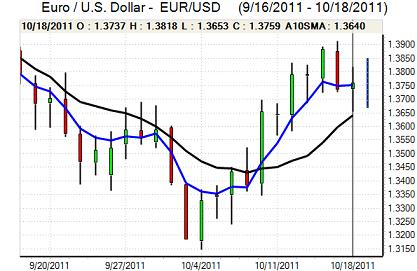EUR/USD
The Euro tended to weaken in European trading on Tuesday as underlying fears surrounding the debt crisis persisted and it dipped to lows near 1.3650 before finding support.
The latest German ZEW index weakened to a 34-month low of -48.3 from -43.3 the previous month and the Institute warned that Germany could already technically be in mild recession. The data reinforced fears over the growth outlook, especially given Germany’s pivotal role in the Euro-zone.
ECB President Trichet stated that monetary policy could not compensate for government errors in the past. There was further speculation surrounding the banking sector during the day and there were further uncertainties surrounding France’s AAA credit rating after it as put on review by Moody’s.
There were fears that EFSF expansion would increase the threat of a credit-rating downgrade and there were also fears that measures to boost banking-sector capital ratios would trigger a cut-back in lending and thus prove counter-productive to economic recovery.
The US NAHB housing data was stronger than expected with a gain to 18 for October from 14 previously while the producer prices data was also stronger than expected. The data will lessen recession fears to some extent and will tend to have a mixed dollar impact as underlying risk conditions could also improve slightly which would curb any defensive dollar demand.
The Euro briefly rallied back to the 1.38 area on media reports that there would be French-German agreement to expand the EFSF fund to EUR2trn through leverage. Choppy trading continued to be an important feature as the Euro weakened again as Moody’s downgraded Spain’s credit rating for the third time sine June 2010 before rallying back to the 1.38 area as hope again gained the upper hand.

Source: VantagePoint Intermarket Analysis Software
Call now and you will be provided with FREE recent forecasts
that are up to 86% accurate* 800-732-5407
If you would rather have the recent forecasts sent to you, please go here
Yen
The dollar tested support levels below 76.80 against the yen on Tuesday, but selling pressure failed to develop any momentum and the US currency was generally trapped in very narrow ranges. Firmer than expected US data did provide some yield support for the dollar.
There were reports that the government will create a new committee to oversee steps to address currency strength. One of the key questions that needs answering is whether there will be attempts to cope with a very strong exchange rate by strengthening competitiveness or whether there will be active attempts to weaken the yen.
The dollar edged lower in Asia on Wednesday as the yen held steady in the face of improved risk appetite.
Sterling
Sterling was unable to regain the 1.58 level against the dollar during Tuesday and dipped to lows below 1.5750 ahead of the UK data. The consumer inflation data was stronger than expected with an increase in the headline rate to 5.2% from 4.5% previously. This equalled the highest rate seen over the past 20 years and matched only once in 2008.
Despite spiking briefly, Sterling was generally weaker following the data and dipped to lows below 1.5650 as the dollar also secured wider gains. Markets assumed that there would be no policy response from the Bank of England as it focuses on demand weakness, especially as the central bank is expecting the inflation rate to fall sharply in 2012.
There were also fears that an increase in inflation would trigger a further squeeze on consumer incomes and undermine the economy as a whole. Real interest rates remained even more negative following the data and this also posed important risks to the UK currency. There were also increased fears of stagflation surrounding the economy and currency which undermined confidence.
The MPC minutes will be watched closely on Wednesday to assess the depth of central bank pessimism and fears surrounding the Banking sector. Sterling rallied back to the 1.5750 area on wider US losses and some underlying speculation over reserve diversification.
Swiss franc
The dollar found support in the 0.8950 area against the franc on Tuesday and rallied to a high around 0.9040 before consolidating in the middle of the range as the Euro held above 1.2320.
There were calls from the Swiss unions that the minimum Euro level should be increase to the 1.40 area from 1.20 now and domestic pressure for a weaker franc will certainly continue as profit margins remain under severe pressure. Speculation over a National Bank shift continued to curb underlying franc support. Any wider Euro gains would increase pressure on the central bank.

Source: VantagePoint Intermarket Analysis Software
Call now and you will be provided with FREE recent forecasts
that are up to 86% accurate* 800-732-5407
If you would rather have the recent forecasts sent to you, please go here
Australian dollar
The Australian dollar was subjected to further selling pressure during the European session on Tuesday and dipped to lows just below 1.0120 before finding support.
Risk conditions remained extremely important for the Australian currency and an attempted rally on Wall Street provided support. High volatility remained an important market feature as the Australian currency rallied back to the 1.03 area in Asia on Wednesday. The currency drew some support from hopes for a soft landing in China even though uncertainty remained extremely high.



